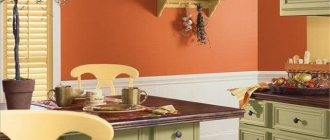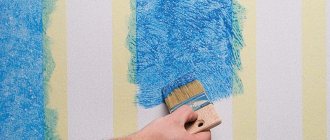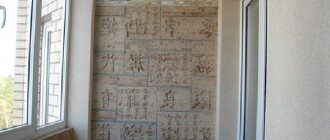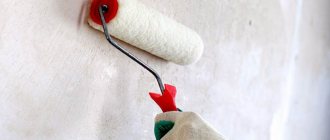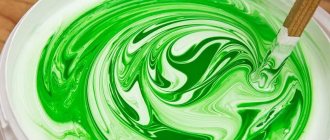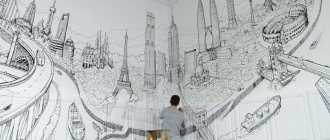Are you tired of your monotonous apartment interior? Do you want to transform it, refresh it and create something extraordinary? Luckily for you, there are many options for decorating a living space. One of them is quite effective - decorative painting of walls with your own hands. Thanks to it, you can change the design of your home beyond recognition. There are many techniques that can help you create a unique pattern and texture on your walls.
It is clear that it is difficult to call the process easy. But if you have the appropriate instructions, tools and materials, as well as the right attitude to work, then you can do without specialists. Let's find out how you can paint walls in a decorative way with your own hands.
What is decorative wall paint and methods of applying it
Decorative painting of walls allows you to obtain a variety of original effects from paint and varnish materials. Special paints are used for this purpose. For example, you can imitate stone, silk, wood and much more. Such a coating will look beautiful and unusual.
Obtaining the effect is possible thanks to the constituent components of the paints. To change the pattern on the wall after drying, special plastic elements are used in the composition.
Decorative painting of walls allows you to obtain a variety of original effects from paint and varnish materials.
Combination with other materials
It happens that in one room the paint is combined with other types of decoration. This helps make the design approach more creative.
Wallpaper and painting
Usually, only one accent wall is decorated with paint or wallpaper, and the others are finished with a second material. Some wallpapers can be used for painting, which will also serve as an interesting solution for a bedroom, office, or living room.
Photo wallpaper and painting
If one wall is covered with photo wallpaper, the rest can be painted. In this case, it is not recommended to use intricate painting techniques, since the photo panel already attracts enough attention.
Plastering and painting
Decorative plasters are covered with paint so that the walls are embossed and evenly colored. You can also combine “bark beetle”, other types of textured plasters and painted walls in the interior of a bathroom or hallway.
Wood and painting
Wooden walls trimmed with panels, lining, timber look good next to painting in the interior of country houses and attics.
Stone and painting
This combination is very typical for decorating the fireplace area, country style kitchen in the apron area. Also, the combination of stone and paint looks good in such style directions as Provence and loft.
Brick and concrete walls with painting
It is better to paint such surfaces with acrylic, latex, and alkyd paints. Artificial aging, drips, artistic strokes, and duets of contrasting colors look original.
Brick and paint
Usually the brick is red or white, less often colored. It can be coated with matching paint to enhance the brightness of the main shade or tinted in any suitable color.
3D panels and painting
Typically, such panels are used in modern interior styles. For them, a single color color is enough to make the design stylish, but not pretentious.
Drywall
Painting drywall is very popular. If you seal the joints well, the result will be perfect, because the walls and ceiling are smooth and have no flaws. You can use any, even the most complex, techniques on drywall.
Advantages of decorative paints
Decorative painting of walls has become increasingly popular lately. The reason is the positive aspects that these paints have. These include the following:
- The service life of the resulting coating is twice as long as that of gluing wallpaper or using plasters;
- The decor helps hide the joint areas;
- A variety of effects that make it possible to implement various ideas;
- Moisture resistant property;
- The ability to update a layer without first removing the previous one;
- The water-based type is safe for human health;
- Suitable for working with any material.
The service life of the resulting coating is twice as long as that of gluing wallpaper or using plasters.
Briefly about the main thing
Briefly about the main thing
Decorative paints differ from ordinary paints in that they contain particles that help form a coating with an additional effect. So, for example, if desired, you can create the effect of a sandstorm on the wall, or imitate a surface covered with velvet, velor, or silk. There are paints that allow you to skillfully imitate the texture of metal. And all this makes the interior more expressive. The technique for applying decorative paints depends on the chosen composition. Relief painting involves applying two or three layers. The second and third layers are applied using a special tool: a roller with a textured roller, a rubber sponge, and a rubbing mitten.
Ratings 0
Types of decorative paints
The construction market offers a huge number of paints for wall decoration, which differ in their properties. To better understand which decorative paint option is suitable, you should study the features of popular products. Each will be discussed in more detail below.
The construction market offers a huge number of paints for wall decoration, which differ in their properties.
Acrylic
This type is one of the most popular. It does not emit an unpleasant odor and has good moisture resistance. Suitable for all types of substrates. There is a large assortment of paint colors, and there are also different effects - glossy, pearlescent, matte and others. The drying process does not take much time.
Suitable for all types of substrates.
Latex
The type is distinguished by its high level of resistance to moisture; the coating can decorate small surface defects. This is a high-quality and expensive product that will last for many years. However, color fading in the sun is noted.
The type is distinguished by its high level of resistance to moisture; the coating can decorate small surface defects.
Water-based
One of the budget options for decorating walls with paint. But water-based paints cannot withstand exposure to moisture. Apply it to a plastered surface, putty, or wallpaper for painting. The composition is colorless; dyes are used to add color.
One of the budget options for decorating walls with paint.
Alkyd, oil
These types of paints stand out for their rich, bright color, form a durable layer on the base, and last for many years. The disadvantages are the strong smell of the product, a small number of shades, high cost and wasteful consumption.
These types of paints stand out for their rich, bright color, form a durable layer on the base, and last for many years.
Silicone
This is a universal type and has a high degree of hiding power. A two-layer coating can cover small surface imperfections. Painting results in the formation of a smooth film that protects the wall from abrasion and creates a moisture-resistant effect.
This is a universal type and has a high degree of hiding power. A two-layer coating can cover small surface imperfections.
Silicate compounds
The composition uses “liquid glass”, it helps to obtain a highly durable coating. They are distinguished by a high degree of vapor permeability. Withstands exposure to high humidity due to the presence of antiseptic components.
The composition uses “liquid glass”, it helps to obtain a highly durable coating.
Which color and style to choose
In order for the room to evoke only pleasant emotions after painting, you need to choose the right colors or their combinations. It is better to strive for your own desires, rather than follow fashion, because it changes almost every year. Here are the most popular paint colors and their purposes:
- white - ideal for ceilings, small rooms, visually expands the boundaries;
- beige is a very popular color, suitable for all types of interiors, looks better in combination with contrasting tones;
- black - reduces space, is used only as an accent, otherwise it will make the room gloomy;
- gray – looks stylish, gives coziness, can become a background for walls, but definitely requires dilution with more “cheerful” tones;
- red is an aggressive color, used in interiors with caution, practically not used in bedrooms and children’s rooms;
- yellow is an excellent color for creating bright spots and diluting a boring environment, especially recommended for northern rooms;
- orange – gives a feeling of warmth, harmony, encourages communication, is popular in the living room and kitchen;
- brown is a classic color in the interior; beige and peach shades go well with it;
- blue – gives a feeling of relaxation, calm, sets the mood for relaxation, its light shades are well suited for the bedroom;
- purple - used accentuated, as in the dark version it can cause a feeling of fatigue;
- green – calms, gives a feeling of closeness to nature, suitable for the living room, bedroom.
Room decoration styles may vary. Depending on the style direction, it is worth choosing both the shade option and the type of wall painting. Here are the most popular interior styles:
- Modern. Usually walls are painted in one or two shades; a popular combination of rich tones with white and beige colors is popular. Stripes and ornaments on the walls work well. The palette should be unobtrusive.
- Minimalism. Plain coloring is used in colors such as blue, gray, white. Textured paints and moldings are used.
- Loft. Typically the design includes brown, gray, black tones. Often a wall painted “like brick” is introduced.
- Classic. The interior can be decorated in any color, preferably pastel colors with ornaments, monograms, and gilding.
- Provence. Blue, lilac, mint tones, pink and peach shades are used. The walls can be plain or striped; artistic painting is popular.
- Country. Stone textures, mustard, white, brown tones, antique effects and whitewash are used.
Is it possible to create a decorative effect using regular wall paint or why pay more?
You can use several simple techniques to get an unusual effect without special paints. An example is applying one layer of water-based paint, onto which another color will be applied with a sponge. The result is a “crumpled paper” effect.
To obtain the marble effect, the surface is painted sequentially in different colors, then treated with a stiff brush, and a special wax should be applied. Fabrics, yarn and other available materials are also used for various options.
You can use several simple techniques to get an unusual effect without special paints.
How to paint walls with a roller
If you decide to apply paint with a roller, first paint with a brush near outlets and switches, behind radiators and around baseboards. Place a wire mesh on the bucket, with its help you can remove excess paint. The paint tray already has a ribbed part, after dipping the roller into the paint, run it up and down along the ribbed part of the tray, this will help remove excess paint and ensure it is evenly distributed. How to paint a concrete wall? Painting the walls starts from the windows and ends near the doors. To paint walls with water-based paint without streaks, alternately roll vertical and horizontal stripes. The roller evenly adheres to the surface and distributes the paint itself.
For painting walls with water-based paints, a felt roller is most suitable. If you are using a new roller, roll it over the sticky side of the duct tape to remove any lint.
Tools needed to create an unusual decorative effect when painting a wall
To treat the wall surface with decorative products, you should purchase tools for the job in advance. Without them, it will not be possible to get the desired result. For repair you will need:
- Paint roller;
- A variety of spatulas: plastic, metal, rubber, serrated;
- Sponges;
- Hard brushes to remove build-up;
- Sandpaper;
- Stencils.
To treat the wall surface with decorative products, you should purchase tools for the job in advance.
Preparing textured paint
Before using textured paint, you should carefully study its instructions, which indicate the drying time, preparation procedure and application tips. Mostly such mixtures are sold in plastic buckets.
Its consistency is impressively dense, which is why a small amount of water is added to it before application, after which mixing is carried out using a drill with a mixing attachment installed. In this case, the main thing is not to pour more liquid than necessary, since as a result the product may no longer fully adhere to the base due to its excessive rarity, for example, on the ceiling. When diluting, experts do not recommend adding more than 1/10 of water relative to the total volume of the mixture. In practice, on average, 4% is enough for optimal stirring.
If, according to the plan, the surface should be painted in a color other than white, then a suitable pigment is added to the mixture.
It is best to entrust this task to the sellers of the store where the paint is purchased. When adding color to the mixture yourself, you must carry out the procedure extremely carefully, pouring the pigment little by little.
After each portion, you need to pause, stirring and checking the resulting shade for consistency. If the color is still too light, you can continue adding pigment. To check the degree of color intensity, a stroke of paint is applied to an unnecessary piece of wallpaper or other material, which can be dried with a hairdryer to dry quickly. The best quality of pigmentation is achieved by adding a color from the same manufacturer that produces the paint used.
Preparing walls for work
The preparatory stage is an important stage of the entire surface finishing. Experts recommend doing the following:
- Clean the surface of old finish.
- Primer is applied.
- Inspect the walls for evenness.
- Defects are covered with putty solution.
- Sand these areas.
- The primer solution is applied again.
The preparatory stage is an important stage of the entire surface finishing.
Useful tips
Before applying water-based paint, you must mix it thoroughly, and then repeat these steps again after you have selected and added the filler. It is best to use a drill with a mixer attachment. You need to stir for 5 to 10 minutes.
The paint should be applied in a thick layer. It is better to paint over the entire area at once to avoid the visibility of joints. Prepare the tool you will be working with in advance. One important factor is the choice of paint. Pay attention to the brand of the product. It is better to choose well-known and high-quality brands, such as VGT, Magic and many others.
If the paint contains colored solid particles, the surface will have a velor or velvet effect. When adding filler, which includes elements such as quartz sand or shells, the pattern will look like a sandy surface (Atacama).
Matte options are good because light is scattered when it hits the walls, thereby hiding surface imperfections. The addition of special pigment fillers to the paint gives the composition a unique pearl shine.
We recommend: 5 unusual floor coverings
What effects can be created on the wall using ready-made decorative paint?
The number of types of coatings obtained using such compositions is large. You can note the receipt of a pearlescent glow on the walls, which will lead to filling the room with light. The silk covering looks very beautiful and presentable. There are similar effects - velvet and velor. The effect of stone, granite, marble are also popular.
This is a cheaper option than using real materials.
The silk covering looks very beautiful and presentable.
Compositions for the kitchen, hallway and bathroom
Water-based acrylic and silicone paints are suitable for hallways and kitchens. They are resistant to abrasion and can be washed. A pronounced relief in the kitchen will be inappropriate, as it will be more difficult to maintain cleanliness. And with mother-of-pearl stains, the room can be made visually more spacious.
But for the bathroom you need to choose paints that are resistant to temperature and moisture. The options listed below are best suited for these purposes, but not for painting the walls in the room:
- Alkyd. They resemble oil compositions in consistency, but differ greatly in performance characteristics. Painted surfaces withstand elevated temperatures, high humidity, and exposure to ultraviolet radiation. Vapor permeability is average, can be applied to metal and wooden elements. The alkyd mixture can be matte, glossy, or semi-matte. Among the disadvantages: it is diluted with organic solvents, which cause a characteristic pungent odor. Inexpensive option, but not particularly durable.
- Based on silicates. An excellent choice for the bathroom. Thanks to the special chemical composition, you don’t have to worry about mold or mildew forming on the walls over time. The result is a durable and strong coating with very high vapor permeability. While the composition dries, it is harmful to health - this is a big minus. You must work in protective clothing. Silicates are not compatible with other types of coatings, so they are not applied to surfaces that have previously been painted with other paints (it will need to be completely removed).
Painting design
There are a lot of options for painting walls in an apartment. You need to find the right combination of colors, but often this is a matter of taste. But different methods of combined painting can significantly change the home interior.
Horizontal division into zones
It is considered the traditional way. More often, the room is divided into two zones: the bottom is painted with dark shades, the top is painted with light shades. Classic: divided in height into three parts. Here the bottom is decorated with a dark shade, and the two upper parts of the walls are decorated with light shades. If you want to decorate the walls with dark shades almost up to the ceiling, then you need to remember that this technique will visually make the ceiling lower.
If you paint on your own, it is difficult to achieve a perfect border between two colors. But you can decorate the imperfections with the help of moldings. Or, before applying other colors, you can carefully stick masking tape along the entire length, helping yourself with a level. After coloring, the tape is removed and a perfect line is obtained.
The use of moldings can be classified as classic; it is acceptable for country and ethnic styles. But the design with a shiny stripe or just clear boundaries is closer to hi-tech or minimalism.
Accents with flowers
Accentuating a wall is a fashionable technique when decorating a room. One of the walls is highlighted in a different color. This is usually a darker tone of the background color or a color that matches the background color. Both options look attractive if you choose the right details. This is an easy way to transform your interior, making it brighter.
But in the bedroom it is advisable not to use harsh combinations - the atmosphere there should be soft. Sharp contrasts look good in children's rooms and living rooms.
Stripes on the walls
The “Horizontal Stripe” color type is appropriate when you need to draw attention to certain decorative elements. A fairly wide strip is placed at eye level
This technique is suitable for a hallway: when the ceiling height is lowered, the corridor itself visually becomes wider.
Striped walls are also a very interesting design technique, but it’s better not to use it throughout the room. But it’s suitable for accenting one wall. An interesting effect will be achieved by combining stripes of the same color, but with different textures - glossy and matte.
Highlighting interior details is a technique that is used very often. Sometimes some details are emphasized with a calmer or brighter color: frames, niches, space for placing a beautiful decorative shelf. A popular option: outline the walls with a strip of dark color, highlighting all the corners. A small room will immediately become visually more spacious: it will “expand” both in width and height.
https://youtube.com/watch?v=N6Q707a8UB0
Application methods
Special products are expensive, so craftsmen resort to a variety of methods to create the desired effect using conventional paintwork materials. Decorative painting of walls with your own hands, unusual application methods will be described below.
Special products are expensive, so craftsmen resort to a variety of methods to create the desired effect using conventional paintwork materials.
Textured coloring
To obtain a voluminous coating, you can use a sponge, which results in a rocky surface. Textured paints contain quartz sand, which gives roughness. A brush with long bristles will help to form different voluminous lines, while a brush with short bristles can be used to create drawings.
A brush with long bristles will help create different voluminous lines.
Frottage
For this technique, take a plastic bag or paper. With the help of which a pattern reminiscent of compressed paper is created on the painted surface.
For this technique, take a plastic bag or paper.
Sponging
For sponging, you need to use a sponge with large pores to apply paint on the wall in a chaotic manner; the colors may vary. The result is a bright coating.
Sponging requires using a sponge with large pores to apply paint on the wall in a chaotic manner.
Using a fabric roller
The step-by-step process for obtaining such a coating involves painting the surface with one layer of paint. After it dries, choose a different shade, darker than the main one. It is applied with a roller covered with fabric. Painting is carried out from below, movements are made in different directions.
Painting is carried out from below, movements are made in different directions.
Ornament
To create an ornament, paint the wall with two colors of paint. The second color is applied with special textured rollers; the shape is selected based on the design. You can also wrap the roller with yarn or fabric.
To create an ornament, paint the wall with two colors of paint.
Color combination
For this technology, several colors of dye are prepared. They are selected to match the overall interior. Selected colors are applied one by one to achieve an unusual design.
Selected colors are applied one by one to achieve an unusual design.
Gradient and ombre
On the surface, the color transitions into darker or lighter shades. To carry out coloring, the paint is diluted with the pigment in stages, the composition is applied one by one, with one roller, so that a gradual transition occurs.
On the surface, the color transitions into darker or lighter shades.
Borders
You can remove the boundaries of color transitions using a sponge, which will gently smear the product on the surface, then the painting will look natural.
You can remove the borders of color transitions using a sponge, which will gently blur the product on the surface.
Stippling
Get an aging effect. The wall is painted in one layer, colored glaze of a suitable shade is applied on top, it is smoothed with a brush, then the uncured areas are treated with it. Use a round brush to press on the walls to obtain the required coverage.
Get an aging effect.
Skin effect
Latex paint is applied, glaze mixed with latex paint is applied to the first dried layer, the shade should be darker. The solution is smeared onto a section of the wall, then pressed on it with a suede brush.
Latex paint is used.
Venetian plaster effect
Paint is poured into the container for the roller, into which pigment is added, more in one half to get a darker color, less in the other. The colors are applied to the wall one by one. Then the roller is moved randomly.
The colors are applied to the wall one by one.
Horizontal division
The room is zoned, a dark color is applied below, a light color is applied above. Only small stripes can be applied around the perimeter of the room.
A dark color is applied below, a light color on top.
Horizontal and vertical stripes
Following the example of the previous method. Make stripes of different colors either vertically or horizontally. The result is a modern design. The main color of the wall should be lighter.
The main color of the wall should be lighter.
Stencils
Using stencils is easy. With their help you can create various designs on the wall. The color of the picture can be contrasting, or just a different shade of the main one.
With their help you can create various designs on the wall.
Divorces
Pearlescent paint is usually chosen for stains so that they create an unusual glow.
Pearlescent paint is usually chosen for stains so that they create an unusual glow.
Contrasting paint using masking tape
Masking tape will help differentiate the application of contrasting colors. It is glued along the perimeter where the first color should be applied and then in order. After the composition has dried, the tape is removed.
Masking tape will help differentiate the application of contrasting colors.
How to paint a ceiling without streaks?
How to paint a ceiling without streaks?
In order to paint the ceiling without streaks, you don’t need a qualified team of construction workers. You can solve this problem yourself. Of course, there are secrets for perfect painting, and yet - the matter is not as difficult as it seems.
For this purpose, you need a number of tools, good preparation of the surface of the ceiling, which needs to be painted afterwards.
To ensure that everything is at hand, it is important to make a list of the necessary materials and purchase everything you need.
You cannot do without the following tools: a ladder, a basin, overalls (with a cap), glasses, paint. paint brush, tape, roller and good quality paint. It is not difficult to determine its quantity; on average, 1 m² is 300 grams of paint.
When you already have the materials and tools, you need to start preparing the room: empty the room of furniture, carpeting (walls, floors), and equipment. If this is not possible, you can simply cover the whole thing with oilcloth or film.
It is imperative to prepare the ceiling for painting. To do this, you need a clean and dry rag, which is used to wipe the ceiling, and then remove the remnants of old paint. How to quickly peel off old wallpaper. If there are places on the ceiling with fungus or mold, then I treat them with an alkaline solution.
Certain areas that are not planned to be painted are covered with tape.
When the preparatory work is completed, the priming work begins. For priming the ceiling, acrylic primer is considered the most suitable. Afterwards the actual painting begins. Take a roller (only wide), a water-dispersion paint solution and paint the ceiling in one layer. After finishing the work, you can see flaws on the ceiling from below; they should be painted over very carefully, slowly.
Now take the undiluted paint and apply one layer to the surface of the ceiling with a roller (or a paint brush). You need to paint from the edges to the center of the ceiling. The result should be stripes that may overlap each other slightly. On average, the strip should be about 50 cm wide and 1 meter long.
A lot depends on the direction of the paint layers. The penultimate layer is directed perpendicular to the window, and the very last layer is directed parallel to the window.
It is advisable to use several rollers (small to medium nap) to apply the final coat of paint on the ceiling. Please note that foam rollers are not suitable for this purpose.
You need to wait some time between layers of paint, that is, until it dries completely. If you rush, the paint will begin to fade and it will not be smooth either.
When completing the work, the joints of the strips must be cleaned using sandpaper. This is the only way to achieve the effect of a uniformly painted ceiling, as a result of which the stains are almost invisible.
Cost of decorative paint from different manufacturers
To understand in advance how much paint for a particular company will cost, you need to calculate the area of the room. Professionals say that decorative paints are economical to use. Typically, 2.5 liters of paint are enough to paint 40 square meters. Consumption can always be seen on the packaging.
Of course, the price will depend on the class of the company. Cheaper products from domestic manufacturers, for example Tex. Among the foreign ones we can highlight funds from Tikkurila, San Marco and others.
To understand in advance how much paint for a particular company will cost, you need to calculate the area of the room.
Decorative paints make it possible to create an original interior. The finish will last for many years and will delight property owners with its durability. The main thing is to decide on the method of application.
How to do it yourself
Similar compositions for textured coatings can be made with your own hands. For this you will need:
- Dye . For the facade, silicone is better, for interior decoration - water-based or acrylic.
- Kohler . A universal water-based one will do.
- Fillers : sand, mineral chips (granite or marble), crushed gas silicate, foam balls, fabric fibers, sawdust, etc.
You need to choose the proportions of relief additives and paint yourself, depending on the desired result. But it is worth remembering that if added excessively, fillers will peel off the walls and crumble.
The tinting paste is injected directly into the container with textured paint. The amount of additive depends on the desired brightness of the shade. For example, Titian color (Ticiana Mix) can be added up to 10% of the volume. Then everything is mixed manually or mechanically. When using a mixer, you need to make sure that the mixture does not foam too much, because... this will make its application worse.
Texture fractions are poured into the container. To give a rough effect, you can add 5-10% pure sand to the paint. A paint tray is also suitable for mixing components.
